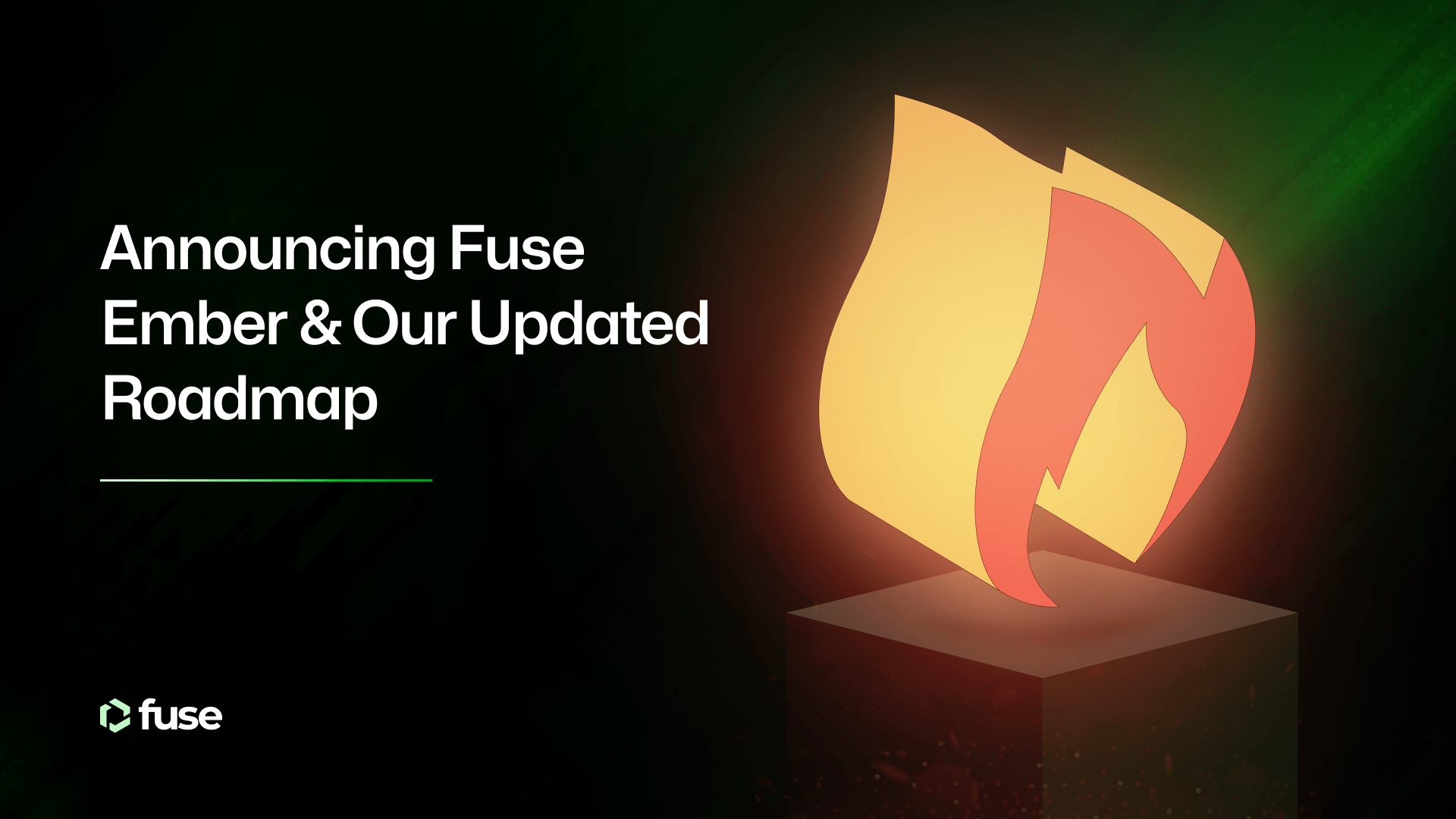Fuse Network is embarking on a significant update to enhance ecosystem scalability and efficiency in the rapidly evolving blockchain landscape. Last December, we communicated our goal to revamp our network architecture by moving to a modular architecture based on zkEVM. The Fuse team has been implementing the plan to enable scaling and privacy for business payments on Fuse, and this strategic shift involves transitioning our core network to a zero-knowledge powered L2 on Polygon CDK after several years of research and development. The focus is on supporting new business models, enabling new use cases, and promoting the seamless integration and collaboration of multiple decentralized financial services and applications.
The Start Of A Journey
Fuse was created with the goal to empower small-to-medium-sized businesses (SMBs) and emerging markets by leveraging the full potential of blockchain technology. Serving as the foundational layer for a future where financial systems are more open, inclusive, and accessible for everyone—especially those underserved by traditional institutions. Since inception, we have worked on breaking down the barriers that keep many businesses and individuals locked out of the global financial system, paving the way for a decentralized, borderless, and fair economy. With this upgrade, we’re getting closer to our goal of supporting 9,000 TPS to mirror VISA’s scale in the web2 space.
Originally launched in 2019 as an EVM-compatible chain, Fuse onboarded over 3.7 million unique accounts and facilitated over 170 million transactions with low gas fees. This strong foundation allowed us to experiment with payment solutions and blockchain applications for businesses looking to enter Web3. Blockchain technology has finally reached the maturity to surpass traditional systems like Visa in terms of performance, transaction speed, and privacy.
To address the growing demand for privacy and security, we are integrating zero-knowledge (ZK) technology into our platform. This choice ensures that Fuse not only remains at the forefront of blockchain innovation but also provides robust privacy features for users and businesses alike.
Moving to Polygon CDK is part of our broader strategy to put Fuse at the forefront of the new truly digital and global economy by balancing scale, security, and decentralization. The next stage in the evolution of Fuse Network leverages zkEVM L2 technology to further drive financial inclusion through an integrated finance ecosystem that is open, transparent, and secure. Here, we’ll dive into the timeline, changes to the token model and community involvement required during the process, which will radically transform how Fuse operates over the course of next year.
Key Network and Client Updates
The planned updates to the Fuse Network will take place over three stages to enhance the chain’s capabilities and align with the latest Ethereum standards. First, we focused on ensuring Ethereum compatibility by deprecating our old Open Ethereum clients and upgrading Fuse to the latest EVM version via the London Hard Fork, incorporating new standards and features. Second, we are changing our current tokenomics, including increasing the maximum staking requirements, to improve network efficiency and stability for validators. Additionally, after five years, we will remove inflation to ensure long-term sustainability. Lastly, we will introduce new tokenomics upgrades to support our migration to zkEVM, leveraging advanced technologies like Zero-Knowledge Proofs for new utility, improved scalability, privacy, and efficiency.
These updates and improvements on the Fuse Network will create a more robust and user-friendly blockchain environment with multiple benefits for users, developers and businesses.
Polygon CDK Integration
The transformative impact on Layer 2 chains with ZK technology delivered through integration with Polygon’s CDK is hard to ignore. Integrating their modular, open-source solution will revolutionize Web3 payments with improved scalability, customization, privacy, and robust Web3 support. The migration will occur in stages, including the deployment of ZK rollups, integrating L1 and L2 communications, and transitioning to ZK Validium. This move will significantly improve transaction throughput, reduce costs, and offer advanced privacy features through Zero-Knowledge Proofs. Bringing low transaction costs, instant finality, high throughput, and decentralized security to blockchain payments will strengthen Fuse’s mission of building a more high-throughput environment for finance in the blockchain world.
- Higher Transaction Volume at Lower Costs: Adopting Polygon’s CDK will increase the number of transactions the Fuse Network can handle at reduced costs. This is crucial for providing the seamless operations and cost savings businesses need to thrive in Web3.
- Seamless Integration with Polygon Ecosystem for Enhanced Interoperability: Integrating the Polygon CDK will enable seamless interaction between the Fuse Network and other Polygon chains for improved ecosystem efficiency and connectivity. We will leverage pooled liquidity across various chains to enhance transaction speeds and reduce costs.
- Advanced Customization Options: Enhanced customization features will allow businesses to tailor the blockchain experience to their specific needs.
- Zero-Knowledge Proofs (ZKPs): With the implementation of ZKPs, transactions can be validated without revealing sensitive information for improved security and privacy for users and organizations.
Community Node Sale Ahead of Mainnet
As Fuse continues to grow, our mission is to build one of the largest web3 Layer 2 ecosystems – and we’re just getting started. We will also be holding our first Network Bootstrap Event to give the Fuse community the chance to become integral members of the network. Node licenses, represented as NFTs, will grant participants the right to operate a Fuse Ember node within the Fuse ecosystem or delegate their licenses to node operators to earn rewards.
This opportunity is geared towards long-term holders and new partners who will play a critical role in the network’s future as we raise funds to accelerate the transition to the Fuse Ember L2 network and other initiatives. By gaining exclusive access to revenue sharing, fees, and governance during this pivotal period, we’re building a community that’s not only part of the Fuse Network but also helping shape its future. The key aspects of the event include:
- Ownership and Participation: Node licenses provide ownership and operational rights in Fuse Ember. 50,000 node licenses will be sold as NFTs; they are also transferable and can be sold on the secondary market.
- Community Building: Running and maintaining an active node will grant additional rewards to node operators, incentivizing participation.
- Delegation Rewards: Node sale participants can delegate their NFTs to any existing node operator to distribute the network’s responsibilities and rewards among a wider group of stakeholders, promoting decentralization.
You can find more information on the rewards and delegation conditions in the docs.
Consensus, New Utility, and Tokenomics Updates
There are several changes to the token model that will happen gradually, including the introduction of a new deflationary model and tokenomics, new staking requirements and burning fees. By increasing the staking limit from 5M to 10M for validators, we seek to enhance network security and promote decentralization. The combination of these elements along with a soon-to-come V2 version for FUSE staking bears substantial significance on the value of the FUSE token, working towards reducing inflation and ensuring the long-term sustainability and stability of the network.
- Node Upgrades: The transition from Open Ethereum to Nethermind will enhance network performance and introduce new features from the London Fork, including EIP-1559, which streamlines transaction fees and improves efficiency.
- Consensus Mechanism Improvements: Capping the maximum supply for FUSE tokens will reduce inflation and stabilize the price. The new staking requirements will help promote decentralization and stability.
- Deflationary Pressure: Burning base fees for operators introduces a deflationary mechanism, driving the value of Fuse tokens up over time and making the token model more stable. Adjusting the inflation rate to 3% will contribute to gradually reducing the rate of new token creation, thereby increasing the scarcity and potential value of FUSE tokens.
A Journey in Milestones – Road to zkEVM and Fuse Ember
The combined implementation of these updates marks a turning point in the transition of Fuse Network to Fuse Ember – a more stable and integrated Web3 environment where users and businesses can thrive. The upgrades enable more efficient business models, increase liquidity and price stability, lower transaction costs, improve composability and interoperability with the larger blockchain space, and broaden access to other decentralized financial instruments.
With blockchain technology evolving every day, Fuse Network is taking the next step in its evolution to offer a user-friendly and secure environment for Web3 payments.
Q3 2024: Launch of New Mainnet & Evolution
- Cross-Chain Payments: New business-focused products.
- zkEVM Deployment: Transition to a modular architecture based on zkEVM for the testnet.
- RevShare Staking: Additional revenue from staking FUSE tokens.
- Voltage Finance 2.0: Ecosystem expansion with new products for mainstream DeFi inclusion.
- Charge Web3: Merchants payments on Fuse become available.
Q4 2024: Milestones & Token Model
- 5th Anniversary of Fuse: Website revamp and commemorative NFTs.
- Fuse Ember mainnet launch: The new zkEVM L2 blockchain of Fuse.
- Token Model Update: Evolving the economy to a deflationary model and a capped maximum supply of FUSE tokens.
Q1 (2025): Future Upgrades
- AggLayer Integration: Improved cross-chain bridging within the Polygon ecosystem.
- Decentralized Sequencer Community Pilot: Node sale – bootstrapping Fuse nodes for the new L2.
- Yield-Generating Products: Addition of cross-chain yield opportunities (LSTs & RWAs).
Follow our channels to stay updated on the latest developments:
.svg)
.svg)











